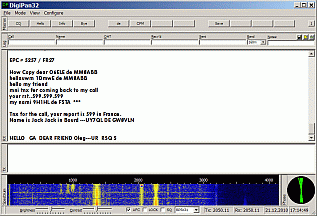In earlier entries I have mentioned the
Softrock SDR receivers which I have been loaned and have been playing around with.These little receivers are single band, fixed frequency affairs. Basically you just feed their output into your computer soundcard, chose one of the many SDR software packages and away you go.
My local amateur friend who loaned me the softrock has recently purchased a Flex Radio HF transceiver. I called around to see it in his shack last week and had a quick tune around and it looks an impressive piece of kit. He is still learning how to use it and this is where I think the SDR rigs fall down at the moment. They are nowhere near "Plug and Play". Now thats fine in itself as part of the hobby is about learning and self improvement. The problem here thogh is you don't need to learn about radio its
computer knowledge that counts. Knowing which operating system will or wont work with your software, installing USB drivers, dealing with incompatible soundcards, not your usual radio related problems.
I have been dealing with some of this myself this week. My friend having purchased the new rig offered me the loan of his
Elektor Hf receiver. Covering up to 30 mhz this little receiver is an interesting device
but:
The best way to control it is to use the "Winrad" software to which a file can be added that allows it to fully control the Elektor receiver. The problem is however that my main PC uses Windows 7. Windows 7 doesn't like Winrad- it says it is incompatible. Now Windows 7 isn't telling the full truth as I did have the little SDR working well for about 10 minutes or so before Winrad and Windows 7 disagreed and the PC locked up. Now of course Windows 7 won't even open Winrad, or if it does the software instantly locks and cannot be closed!
This isn't too bad a problem because I have an older PC here, which I use for HF data work that runs Windows XP. The only thing now is it is a slow machine 1.3Ghz CPU and 512Mb of memory, it doesn't seem to want to run Winrad. I am going to try to remove as much unnecessary software as I can from this machine and see if I can get it to work but this may take some time.
My point is this, no doubt many SDR transceivers offer superb facilities. But this morning I was able to pop into my shack- I had a few free minutes and take a quick listen on the bands. I turned on my 20 odd year old Kenwood R5000 receiver. I didn't have to wait for it to boot up, it didn't need to recognise a soundcard or any drivers- it was on- instantly and ready for use! What's more, when I was finished it switched off just as easily. As well as this it doesn't have any noisy monitors or peripherals that cause hash on the HF bands. At the moment I am not sure that there are any SDR radios that rival it!
 This is the QSL card and sticker I received from Radio Prague just before Christmas.As a young SWL I used to send reception reports to many broadcast stations (back in the 80's there were quite a few more of them) but its something I have not done for years. When I heard that Radio Prague is to leave the airwaves at the end of January 2011 I thought I would send a report for one of their last QSLs. I am also awaiting a card from Radio Slovakia, another broadcaster about to leave shortwave.
This is the QSL card and sticker I received from Radio Prague just before Christmas.As a young SWL I used to send reception reports to many broadcast stations (back in the 80's there were quite a few more of them) but its something I have not done for years. When I heard that Radio Prague is to leave the airwaves at the end of January 2011 I thought I would send a report for one of their last QSLs. I am also awaiting a card from Radio Slovakia, another broadcaster about to leave shortwave.
















































